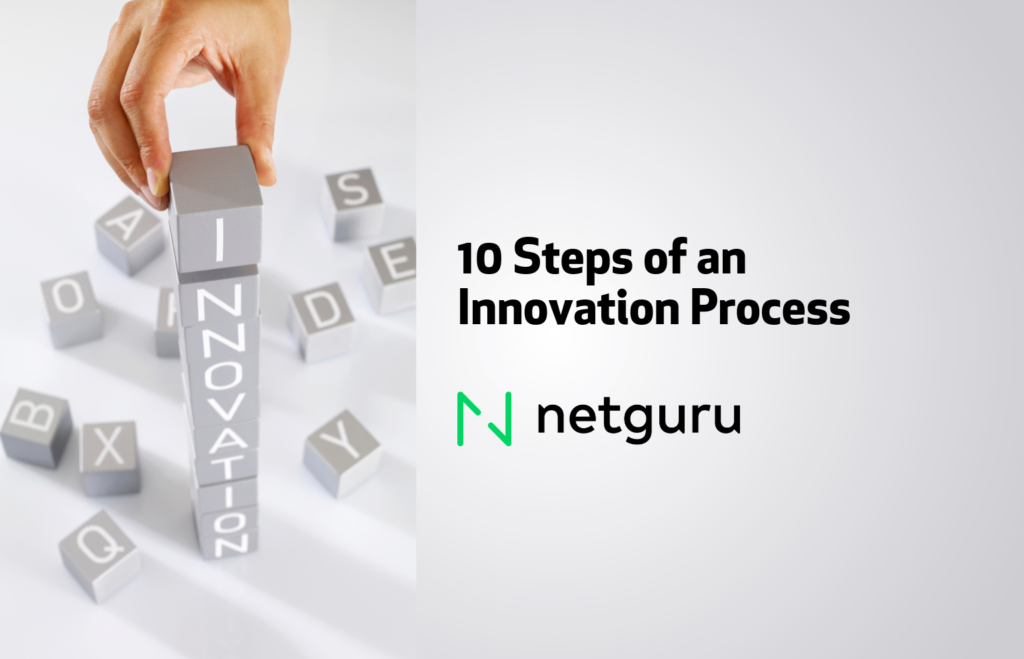10 Steps of an Innovation Process

This article was created in cooperation with Netguru.
Innovation is on everybody’s lips until the moment one has to take risks or change things up. Embarking on an innovation process can be intimidating when getting started. Employees can be skeptical especially when everyone is used to how they do their work. However, when innovation is spoken of, it’s probably because of subtle signs that the business already needs to change course in some regard.
Case studies abound on how companies without appetite and strategy for innovation have succumbed to stagnation, if not outright decline. Companies averse to fresh and creative approaches tend to rest on their laurels, giving way to outdated product features, degrading customer experiences, dissatisfied employees, and novel approaches from competitors, which can ultimately constrain growth.
To mitigate these risks, businesses can innovate, which entails challenging themselves to outgrow (but build on) past and existing successes of solving customer problems. Because this is a long-term endeavor, organizations can jumpstart a culture of innovation by embarking on high priority innovation initiatives. In this guide, we’ll discuss the 10 steps your business needs to take when initiating an innovation process.

What is an Innovation Process?
An innovation process is a set of strategic steps — marked by taking creative and fresh approaches — designed to achieve a set of organizational goals within a specific timeline. It’s a deliberate intervention to try out new ideas in solving concrete business problems.
Innovation processes, when new to an organization, can arise from, among others, persistent issues wherein previous solutions haven’t worked out as planned. These problems could relate to declining growth, product stagnation, organizational bureaucracy, customer dissatisfaction, and many others with varying magnitude. These typically drag on and create new other problems despite attempts at solving them to the point that company leaders decide to take a step back and recognize that they need to approach it in a radically different fashion.

Innovative Idea Generation: Easy to Say, But How to Execute?
Taking concrete steps to become a more innovative company isn’t an end in itself. It shouldn’t be done for self-gratification just to be able to say that we belong to an innovative organization. In fact, this can paralyze companies from starting innovation initiatives, obsession over the question: How can we be more innovative?
To begin this journey, managers simply have to look at their business priorities. It’s always an imperative to introduce and integrate innovation processes within the broader context of desired business outcomes. Start exploring creative solutions either for the biggest and most pressing problems or low-hanging fruits that you can more easily address (or both).

Running a successful innovation process in 10 steps
There’s no single roadmap to achieve success for an innovation program. Building any type of organizational culture is complex and dynamic and there isn’t any silver bullet. You’ll need to adapt interventions based on the problems you wish to solve and the resources that you have. Consider these ten steps as a guide to jumpstart your innovation journey.

Step 1: Define innovation
For businesses new to a serious pivot towards becoming more innovative, this process will seem and feel ambiguous. If not introduced properly, it’ll come across as if company leadership is adopting a mere jargon or slogan. It’s vital to communicate that you’ll be embarking on a strategic process to take on creative, bold, and fresh ideas with strong potential to deliver meaningful results to the firm.
Convey that this is a new direction that will be backed by resources, structure, training, and real support from company leadership. Follow up by continuously emphasizing your new set of expectations from your entire company and the innovation team you’ll be putting together.
Reinforce this shift by taking initial steps on novel ideas that your employees have proposed before but have never been acted on. To get the ball rolling, illustrate to them what kind of fresh approaches you’re looking for. Make it clear that as you introduce this new innovation process, that everyone can contribute and shape it no matter their role in the company.
Step 2: Define the goals
Innovation processes often do not produce positive results when they are not aligned with business goals and priorities. While anyone might engage in an innovative undertaking merely for the sake of innovation, businesses and organizations naturally must prioritize resources and direct them to real and pressing problems.
Further, even as innovation initiatives have to support broader corporate metrics (e.g. user growth, revenue, profitability), innovation processes typically deal with targeted problems. They could be about reinventing a specific product feature, breaking into a new customer segment, or speeding up turnaround times for a particular workflow.
Whatever the persisting issues are, managers must break them down to specific problem statements that their designated teams can solve. With clarity comes better oversight over the innovation process. Those working on them can design better strategies, pick the right methods, and filter all creative ideas towards a shared understanding of the problems at hand.
Step 3: Assemble your team
When designing and implementing an innovation initiative, it’s critical to assemble a team that’s committed to new, creative, and innovative approaches across all levels, from the most senior executives to the specialists. Because an innovation process is inherently in the business of trying out fresh and out-of-the box ideas, company leaders have to exercise judgment on deploying individuals who have been working on the same problem for quite some time.
You may stick with an existing team, pull in individuals from other departments, or create an entirely new group. Whatever the approach may be on manpower, the more important factors are the availability of the required skills (e.g. technical, managerial) and commitment to creativity.
Furthermore, the spirit of innovation requires openness. This means that you need to choose team leaders who have innate abilities that open up spaces for creativity and for fresh ideas to flourish whomever they come from. Reorient managers to give team members space to pitch ideas and try them out.
To seed the right mindset from team members, consider giving them autonomy over some of their proposals. Build an environment where they can properly see that their own work could have a meaningful impact to the business and its customers. You can also explore providing incentives to those who are able to solve enduring problems. They will always be a slice of any workforce that won’t feel invested in any new endeavor unless there’s a reward for extra work, especially if it’s creative in nature.

Step 4: Secure the budget
What’s the use of initiating an innovation program if your business won’t fund its most promising ideas? To get it off the ground, you need to prove to your staff that you’re serious in trying out the creativity you’re asking from them. Do this by soliciting inputs on how to reallocate the budget when beginning an innovation process.
To be fair, the right ideas might not be there yet in the early stages. Have funding necessary to put structures in place such as crafting an innovation strategy, setting up collaboration tools, organizing workshops, and upskilling team members. This also includes processes and initial resources to analyze and test ideas. When the right idea comes, then the team can produce a detailed financial proposal that you can more easily evaluate to trigger the appropriate funding for implementation.
Furthermore, don’t assume that innovation and creativity come easily to everyone just because they’re given the space for it. In this regard, consider building capacity through training and exposure to external practices. Invest in upskilling your teams. Integrate topics on innovation to your professional development program.

Step 5: Create diverse teams
Most people recognize that organizations benefit in a number of ways from having a diverse workforce. Facilitating innovation is one of these benefits. Having an innovative culture entails being welcoming of a broad range of ideas wherever or whomever they come from. Greater diversity within innovation teams empowers them to draw from a wider range of ideas and how to implement them.
For instance, inherent diversity (e.g. ethnicity, gender) enables companies to be more sensitive to a broader range of customer experiences. Acquired diversity (e.g. work experience) can give teams transposable ideas based on how things are done in other industries or countries.
Diverse innovation teams can also reduce blind spots. Team members of diverse teams tend to be more open and willing to share out-of-the-box ideas because they’re exposed to a variety of attitudes and backgrounds, creating a laboratory for creation unhindered by monolithic thinking.
Step 6: Select collaboration tools
To set up innovation teams for success, organizational leaders must create an environment of collaboration, communication, and trust. This could come in the form of dedicated time and physical spaces that enable experimentation and exchange of ideas. To begin with (and at the very least), companies must provide them with the proper collaboration tools to get the innovation process going.
Enterprises and bigger organizations have the advantage of deploying tools that they already have. Employees should already be familiar with them, which reduces the friction of starting new projects. If necessary, companies may also explore building their own custom tools if the project they’re working on requires it.
Technology should play an invaluable role not only in collaboration but throughout the innovation process, from discovery, research, analysis, testing, prototyping, all the way to product development and implementation. The key factor here is for the work to be done collaboratively, not in silos, which is often a symptom or cause of the problems that necessitate innovation reforms in the first place.
Step 7: Don’t be afraid to take risks
High level organizational leaders, especially shareholders, board members, the CEO, and c-suite executives must recognize that not all seemingly innovative ideas are viable or will be successful. Because some of them may feel that way in the beginning, leaders mustn’t be naive that all outputs of their innovative processes will be successful.
While no one sets out to fail, companies shouldn’t be averse to taking risks which is inherent to the nature of innovation. Furthermore, companies must give their teams space to learn from innovation projects that don’t work out as intended.
One way to manage this risk is to build a strong system for validating ideas. To filter for ideas that have a strong chance of delivering value to the company, teams should establish methodologies for idea validation by deploying rigorous research, analysis, testing, and experimentation, among other methods.

Step 8: Implement incrementally
While fresh and creative ideas fuel innovation, these ideas don’t run on their own. Recognizing the risks of a new project, innovation teams simply have to get on with it despite fears of failure. Build (or rebuild) that new product, test that new business model, or experiment with that new internal workflow.
One risk to innovation initiatives is that they’re put aside as a research or ideation project because of company resistance, risk aversion, lack of financing, or it’s too far out there. Whether your innovation team is working on an incremental innovation or a game changer, trust that they’ve done their homework (because you’ve asked them to) and allow them to build and implement their idea.
Execution of innovation projects isn’t necessarily a scattershot. Just like conventional product development, innovation isn’t random or accidental but a methodical process that goes through iterative bouts of proofs-of-concept, prototyping, user testing, and experimentation until the team has relative confidence that when launched, the output can generate meaningful value to the business.
Step 9: Evaluate and improve
While the innovation process is marked by experimentation of new approaches, it’s still helpful to use metrics and benchmarks. Don’t be averse to setting KPIs or looking at competitors for benchmarks while recognizing that you may uncover other forms of value that you may not account for in the beginning. Setting targets and indicators helps you evaluate whether your innovation project can be viable for the firm.
Even when a novel idea doesn’t work out, take the time to evaluate why that is. Take underwhelming results as opportunities to learn and improve your structures and systems for innovation so you can narrow your focus to projects that have a better chance of success. Treat each failure as an opportunity to improve your overall innovation strategy and process.
When an innovation initiative bears fruit, understand the factors for success to help you replicate them for other projects. Even when the results are promising, you can always iterate and improve further to double down on your success.
Step 10: Work on your culture of innovation
Rather than treating an innovation initiative as a special project, consider making it part of your organizational culture. Taking risks on creative approaches should be an integral part of business planning, product conceptualization and engineering, reconfiguring internal workflows, brand development, and in any other part of the business.
Building an innovation culture entails creating an environment that fosters creative thinking to generate value for the organization. A culture of innovation isn’t just a one-time thing where organizations partition one activity or one part of the business that deals in innovation while the rest of the company carries on as usual. This necessitates leadership, strategy, investment, structure, capacity-building, and accountability among other formal and deliberate interventions.
Those who work in innovative environments recognize that innovation is simply part of their workplace culture. They don’t have to rely on or wait for directives from managers or a special innovation team. It’s simply part of how things work and how they do their work. While this type of ecosystem is one that you’ll need to build for the long term, the barriers are low to get it started.
Innovation Projects Require Courage to Try
The road to cultural transformation will be difficult. Those championing innovation should brace themselves for opposition along the way. Recognize that this is natural and perhaps even necessary. Consider that those who oppose it could be seeing ramifications to their careers and roles within the organization. By communicating and demonstrating that everyone can contribute and be involved, you can overcome this resistance.
If you’re still wary about the risks of taking a pivot towards game changing innovations, you can always start with low-hanging fruits first to demonstrate your willingness to try new approaches. When you see more and more employees buying into this new direction, then you can more comfortably take a crack at the more substantive business problems.
There’s no single way to win hearts and minds but when your team sees your resolve and courage in taking a chance at their very own ideas, no matter how small, you’re already taking the right first steps towards becoming a more innovative company.

The post 10 Steps of an Innovation Process appeared first on MIT Enterprise Forum CEE.
